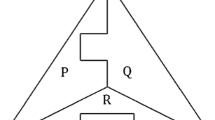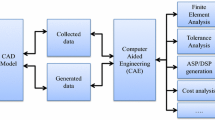Abstract
With the new technologies of the product design, the assembly automation lines has expatriated to a new assembly strategy characterized by an assembly modularization. This strategy consists, in a first time, in preparing subassemblies on secondary lines and then assembled with each other on the main line in a second time. The choice has been made to automate certain sections of the main line and to leave the subassembly lines in a manual way. The aim of this work is to identify the subassemblies of a mechanical product from its CAD model in order to predict secondary’s assembly lines. For better discussing and explaining all the steps of the proposed approach a CAD assembly of an industrial complex product is presented in all sections of this paper.
Access this chapter
Tax calculation will be finalised at checkout
Purchases are for personal use only
Similar content being viewed by others
References
Raju JA (2003) Conceptual design and cost optimisation methodology. In: 44th AIAA/ASME/AHS structures, structural dynamics and materials conference, Norfolk, Virginia; April 2003
Kucukkoc I, Zhang DZ (2015) Balancing of parallel U-shaped assembly lines. Comput Oper Res. https://doi.org/10.1016/j.cor.2015.05.014
Ozdemir RG, Ayag Z (2000) An integrated approach to evaluating assembly-line design alternatives with equipment selection. Prod Plan Control 22(2):194–206
Wirtorsson M, Andersson T, Broman M (2000) A note on the specification of assembly systems. Int J Prod Res 38:3999–4004
Khan AD (2002) A knowledge based design methodology for manufacturing assembly lines. Comput Ind Eng 41:441–467
Barnes CJ (2000) A methodology for the concurrent design of products and their assembly sequences. PhD Thesis. Cranfield University, UK
Ullah S, Zailin G, Li Z, Baoxi W, Jahanzaib M (2017) Multi-objective artificial bee colony algorithm for order oriented simultaneous sequencing and balancing of multi-mixed model assembly line. J Intell Manuf. https://doi.org/10.1007/s10845-017-1316-4
Trigui M, BenHadj R, Aifaoui N (2015) An interoperability CAD assembly sequence plan approach. Int J Adv Manuf Technol 79:1465–1476
Issaoui L, Aifaoui N, Benamara A (2015) Solution space reduction of disassembly sequences generated automatically via computer aids. Proc Inst Mech Eng Part C J Mech Eng Sci 22–16:2977–2986
Kheder M, Trigui M, Aifaoui N (2017) Optimization of disassembly sequence planning for preventive maintenance. Int J Adv Manuf Technol. https://doi.org/10.1007/s00170-016-9434-2
Kheder M, Trigui M, Aifaoui N (2016) Disassembly sequence planning based on genetic algorithm. Mech Eng Sci 229(12):2281–2290
Belhadj I, Trigui M, Benamara A (2016) Subassembly generation algorithm from a CAD model. Int J Adv Manuf Technol 87:2829–2840
Su Q, Smith SF (2003) An integrated framework for assembly oriented product design and optimization. J Ind Technol 19(2)
Barnes CJ, Jared GEM, Swift KG (2004) Decision support for sequence generation in an assembly oriented design environment. Robot Comput-Integr Manuf 20:289–300
Chen G, Zhou J, Cai WC, Lai X, Lin Z, Menassa R (2006) A framework for an automotive body assembly process design system. Comput Aided Des 38:531–539
Author information
Authors and Affiliations
Corresponding author
Editor information
Editors and Affiliations
Rights and permissions
Copyright information
© 2020 Springer Nature Switzerland AG
About this paper
Cite this paper
Belhadj, I., Trigui, M., Aifaoui, N., Benamara, A. (2020). From Assembly Planning to Secondary Assembly’s Lines Identification. In: Aifaoui, N., et al. Design and Modeling of Mechanical Systems - IV. CMSM 2019. Lecture Notes in Mechanical Engineering. Springer, Cham. https://doi.org/10.1007/978-3-030-27146-6_1
Download citation
DOI: https://doi.org/10.1007/978-3-030-27146-6_1
Published:
Publisher Name: Springer, Cham
Print ISBN: 978-3-030-27145-9
Online ISBN: 978-3-030-27146-6
eBook Packages: EngineeringEngineering (R0)




